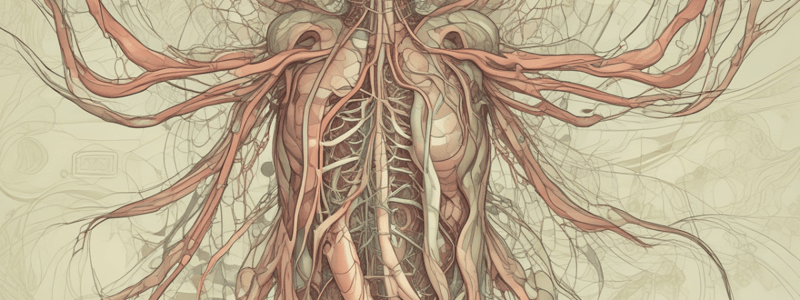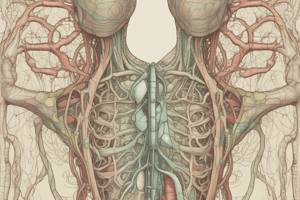Podcast
Questions and Answers
What is the primary function of the lymphatic system concerning fluid management?
What is the primary function of the lymphatic system concerning fluid management?
- To return excess fluid from tissues to the bloodstream. (correct)
- To synthesize proteins necessary for immune responses.
- To transport oxygen throughout the body.
- To filter blood before it returns to the heart.
How do lymphatic capillaries differ from blood capillaries?
How do lymphatic capillaries differ from blood capillaries?
- Lymphatic capillaries have larger openings facilitating fluid uptake. (correct)
- Blood capillaries do not allow any fluid to escape.
- Lymphatic capillaries are smaller and more numerous.
- Blood capillaries are exclusively for protein absorption.
What role do lymph nodes serve in the immune response?
What role do lymph nodes serve in the immune response?
- They produce hormones that regulate fluid balance.
- They filter nutrients before they enter the bloodstream.
- They serve as storage sites for lymphatic fluid.
- They scan for pathogens and house immune cells. (correct)
What prevents the backflow of lymph in lymph vessels?
What prevents the backflow of lymph in lymph vessels?
Where does lymph enter a lymph node?
Where does lymph enter a lymph node?
What is comprised of the cortex of a lymph node?
What is comprised of the cortex of a lymph node?
Which of the following lymph nodes is located near the groin area?
Which of the following lymph nodes is located near the groin area?
Which process primarily causes fluid to leak from blood capillaries into tissues?
Which process primarily causes fluid to leak from blood capillaries into tissues?
Which of the following statements about the right lymphatic duct is true?
Which of the following statements about the right lymphatic duct is true?
What role does the thoracic duct play in the lymphatic system?
What role does the thoracic duct play in the lymphatic system?
Which of the following accurately describes the function of lymph nodes?
Which of the following accurately describes the function of lymph nodes?
In terms of nutrient absorption, how are lipids transported from the intestines?
In terms of nutrient absorption, how are lipids transported from the intestines?
Which structure is primarily responsible for the production of T lymphocytes?
Which structure is primarily responsible for the production of T lymphocytes?
Where do the majority of lymph nodes that drain lymph from limbs pass their fluid?
Where do the majority of lymph nodes that drain lymph from limbs pass their fluid?
Which of the following is incorrect regarding the functions of the lymphatic system?
Which of the following is incorrect regarding the functions of the lymphatic system?
What is the significance of chylomicrons in the lymphatic system?
What is the significance of chylomicrons in the lymphatic system?
Flashcards are hidden until you start studying
Study Notes
Lymphatic System Overview
- The lymphatic system has three main functions: preventing swelling, initiating immune responses, and absorbing fats from the digestive tract.
- Prevents swelling by returning excess fluid from tissues to the bloodstream, avoiding edema.
Fluid Management
- Fluid leaks from blood capillaries into tissues, creating interstitial fluid.
- This fluid includes water, proteins, hormones, and nutrients necessary for cell survival.
- Hydrostatic pressure forces fluid out, while osmotic pressure pulls some back in; however, more fluid leaves than returns, leading to potential swelling.
Role of Lymphatic Capillaries
- Lymphatic capillaries collect excess interstitial fluid, which then becomes lymph.
- These capillaries have larger openings than blood capillaries, facilitating the uptake of fluid and proteins.
Lymph Flow Process
- Lymph moves from capillary beds through lymphatic capillaries to larger lymph vessels.
- It ultimately returns to the bloodstream via veins, entering at subclavian veins.
Immune Function
- Lymph nodes, dispersed throughout the body, are critical for scanning for pathogens.
- Lymph enters the node via afferent vessels, where B cells and T cells are stationed, ready to initiate an immune response.
- Valves in lymph vessels ensure one-way flow, preventing backflow.
Lymph Node Structure
- The lymph node consists of a cortex (outer part) rich in B cells, and a medulla (inner part), where lymph passes through before exiting.
- Blood vessels supply white blood cells to lymph nodes via the bloodstream.
Geographic Distribution of Lymph Nodes
- Lymph nodes are clustered in specific regions:
- Epitrochlear nodes near the elbow.
- Numerous nodes in the axillary (armpit) and cervical (neck) regions to filter lymph from the upper body.
- Inguinal nodes located in the groin area filter lymph from the lower body.
Major Lymphatic Ducts
- Lymph drains back into the circulatory system through two key ducts:
- The Right Lymphatic Duct collects lymph from the right arm and right side of the face.
- The Thoracic Duct collects lymph from the left arm, left side of the face, and the entire lower half of the body.
Overall Pathway of Lymph
- Lymph travels from peripheral lymphatic capillaries through the lymphatic system converging into the thoracic duct and right lymphatic duct.
- The thoracic duct connects to the left subclavian vein, while the right lymphatic duct connects to the right subclavian vein, completing the return to the bloodstream.### Functions of the Lymphatic System
- Returns interstitial fluid to bloodstream, preventing swelling.
- Scans for pathogens and initiates immune response via lymph nodes.
- Absorbs fats from the intestines and delivers them to the bloodstream through lymphatic vessels.
Lymphatic Ducts
- Right lymphatic duct drains lymph from the right upper body.
- Thoracic duct drains lymph from the lower body and left upper body into the left subclavian vein.
Lymphatic Fluid Movement
- Lymphatic vessels collect excess fluid throughout the body to prevent swelling.
- Fluid from intestines is transported via lymphatic vessels to the thoracic duct.
Nutrient Absorption in the Intestines
- Nutrients are absorbed from the small intestine through villi.
- Water-soluble nutrients (proteins/sugars) enter bloodstream directly via capillaries.
- Lipids are packaged into chylomicrons to be transported through lymphatic capillaries due to their bulkiness.
Primary Lymphatic Organs
- Thymus: Produces T lymphocytes; shrinks with age.
- Bone Marrow: Site of B lymphocyte development; produces white blood cells.
Secondary Lymphatic Organs
- Spleen: Acts as a lymph node for blood; filters pathogens and breaks down old red blood cells.
- Tonsils: Contain lymphocytes; located in the throat area, help fight pathogens.
Lymph Node Structure
- Lymph fluid enters through afferent vessels and exits through efferent vessels.
- Fluid is scanned by B and T cells for pathogens in lymph nodes' cortex and medulla.
Lymphatic Fluid Pathways
- Fluid from limbs passes through specific regional lymph nodes (e.g., epitrochlear, axillary).
- Majority of lymph nodes located in the cervical region, draining into the thoracic and right lymphatic ducts.
Conclusion
- The lymphatic system has a complex structure with various components working together to maintain fluid balance and immune response.
- Understanding these components aids in grasping the broader functions of the immune system and fluid regulation in the body.
Lymphatic System Overview
- Three primary functions: prevents swelling, triggers immune responses, and absorbs dietary fats.
- Prevents edema by returning excess interstitial fluid from tissues back into the bloodstream.
Fluid Management
- Interstitial fluid, composed of water, proteins, hormones, and nutrients, leaks from blood capillaries into surrounding tissues.
- Hydrostatic pressure pushes fluid out of capillaries, while osmotic pressure partially pulls it back, resulting in more fluid leaving than returning, risking swelling.
Role of Lymphatic Capillaries
- Lymphatic capillaries absorb excess interstitial fluid, transforming it into lymph.
- Capillaries feature larger openings than blood capillaries, facilitating fluid and protein uptake.
Lymph Flow Process
- Lymph flows from capillary beds into lymphatic capillaries and then into larger lymph vessels.
- Returns to the bloodstream at subclavian veins.
Immune Function
- Lymph nodes act as surveillance points for pathogens, containing B cells and T cells ready to initiate immune responses.
- Lymph enters nodes through afferent vessels; one-way valves prevent backflow in lymph vessels.
Lymph Node Structure
- Structure includes a cortex filled with B cells and a medulla where lymph is filtered before exiting.
- Blood vessels transport white blood cells to lymph nodes via the bloodstream.
Geographic Distribution of Lymph Nodes
- Clusters of lymph nodes are strategically located:
- Epitrochlear nodes near the elbow.
- Axillary nodes in the armpits and cervical nodes in the neck.
- Inguinal nodes in the groin area for lower body lymph filtration.
Major Lymphatic Ducts
- Right Lymphatic Duct: Drains lymph from the right arm and right side of the face.
- Thoracic Duct: Drains lymph from the left arm, left side of the face, and entire lower body.
Overall Pathway of Lymph
- Lymph traverses from peripheral capillaries through the lymphatic system, leading into the thoracic duct and right lymphatic duct.
- Thoracic duct joins with the left subclavian vein, while the right duct connects to the right subclavian vein, completing circulatory return.
Functions of the Lymphatic System
- Returns interstitial fluid to the bloodstream, averting swelling.
- Scans for pathogens and facilitates immune response via lymph nodes.
- Absorbs dietary fats, delivering them to the bloodstream through lymphatic vessels.
Lymphatic Ducts
- Right lymphatic duct primarily drains the right upper body.
- Thoracic duct collects lymph from the left upper body and lower body, draining into the left subclavian vein.
Lymphatic Fluid Movement
- Lymphatic vessels gather excess fluid to ensure proper fluid balance.
- Intestinal fluid is transported through lymphatic vessels to reach the thoracic duct.
Nutrient Absorption in the Intestines
- Nutrient absorption occurs in the small intestine's villi; water-soluble nutrients directly enter the bloodstream via capillaries.
- Lipids are encapsulated into chylomicrons for transport through lymphatic capillaries due to their size.
Primary Lymphatic Organs
- Thymus: Produces T lymphocytes and reduces in size with age.
- Bone Marrow: Site for B lymphocyte development and production of white blood cells.
Secondary Lymphatic Organs
- Spleen: Filters blood, removing pathogens and old red blood cells.
- Tonsils: Contain lymphocytes located in the throat, aiding in pathogen defense.
Lymph Node Structure
- Lymph enters through afferent vessels and exits via efferent vessels; pathogens are scanned by B and T cells in both lymph node cortex and medulla.
Lymphatic Fluid Pathways
- Fluid from limbs passes through specific regional lymph nodes (e.g., epitrochlear, axillary) to drain into thoracic and right lymphatic ducts.
- Majority of lymph nodes are concentrated in the cervical region.
Conclusion
- The lymphatic system integrates multiple components to regulate fluid balance and support immune function.
- Understanding the system's structure and functions provides insight into broader immune responses and fluid management in the body.
Studying That Suits You
Use AI to generate personalized quizzes and flashcards to suit your learning preferences.




